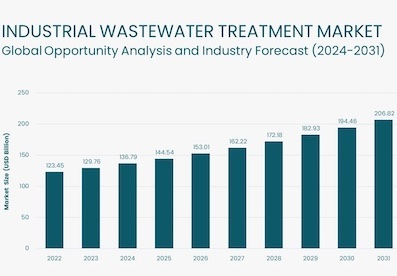 Cleanzine: your weekly cleaning and hygiene industry newsletter 3rd July 2025 Issue no. 1169
Cleanzine: your weekly cleaning and hygiene industry newsletter 3rd July 2025 Issue no. 1169
Your industry news - first
The original and best - for over 20 years!
We strongly recommend viewing Cleanzine full size in your web browser. Click our masthead above to visit our website version.
Industrial wastewater treatment market to reach $ 206.81 billion by 2031
 According to a new market research report, the industrial wastewater treatment market is projected to reach $206.81 billion by 2031 from an estimated $136.79 billion in 2024, at a Compound Annual Growth Rate of 6.1% during the forecast period (2024-2031).
According to a new market research report, the industrial wastewater treatment market is projected to reach $206.81 billion by 2031 from an estimated $136.79 billion in 2024, at a Compound Annual Growth Rate of 6.1% during the forecast period (2024-2031).
This growth is driven by factors such as the lack of freshwater resources, government encouragement and growing emphasis on corporate social responsibility, along with the need for critical resource recovery from wastewater. However, the high installation, maintenance and operating costs of wastewater treatment infrastructure restrain the growth of this market.
The growing demand for energy-efficient and advanced wastewater treatment technologies and the generation of green hydrogen from industrial wastewater, are, however, expected to provide growth opportunities for the players operating in this market. Unfortunately, high energy consumption and expenses - due to excess sludge production - pose significant challenges to the market's growth.
Titled, 'Industrial wastewater treatment market by offering (treatment technologies, treatment chemicals, process control & automation, design, engineering, and construction services, operation & maintenance services), end user and geography- forecast to 2031', the report segments the global industrial wastewater treatment market by offering, end user and geography. The study evaluates industry competitors and analyses the country and regional-level markets.
Lack of freshwater resources supporting the growth of the industrial wastewater treatment market…
Water is the driving force of nature; however, freshwater resources are now depleting at an alarming rate. The global population continues to soar but freshwater supplies have not increased proportionately. Projections by the World Bank indicate that six billion people could face a scarcity of clean water by 2050, driven by the escalating demand, diminishing resources and increasing water pollution. Exponential population growth and rapid industrialisation further exacerbate these challenges.
Demographic pressures, the pace of economic development, urbanisation and pollution are exerting unprecedented pressure on the world's water resources. According to the World Health Organisation, as of March 2022, approximately 2billion people worldwide lacked access to safe drinking water, of which 771 million lacked access even to basic drinking water. The demand for water is projected to exceed the available supply by 40% within the next 20 years, primarily due to issues related to poor sanitation and water management.
Moreover, rising water pollution has led to a decline in the availability of freshwater for various industrial applications, such as processing, washing, diluting and cooling. The rapid depletion of freshwater resources coupled with industrialisation and pollution has resulted in a water crisis in many parts of the world, especially in underdeveloped and developing countries. This crisis is expected to boost the demand for industrial wastewater treatment solutions, driving the growth of this market in the coming years.
Key players in this market are increasingly investing in the development of industrial wastewater treatment infrastructure. For instance, in September 2022, Lanxess (Germany) commissioned a new treatment plant at its Belgium site, with an investment of around USD 13.0 million (EUR 12 million). The plant has a treatment capacity of around 260,000 litres of wastewater per hour.
Based on offering, in 2024, the operation & maintenance services segment is expected to account for the largest share of 40% of the industrial wastewater treatment market. The large market share of this segment is attributed to the increasing need for meeting government-mandated quality standards for managing wastewater and companies' rising focus on cost-effectiveness, efficiency, and reducing workforce requirements for monitoring and managing industrial wastewater.
However, the process control & automation segment is projected to register the highest CAGR during the forecast period due to the rising technological complexities in treatment facilities, the increasing need for operational automation, the rising number of investments in process control systems and the companies' growing focus on achieving cost & energy-saving targets.
Based on end user, in 2024, the food & beverage segment is expected to account for the largest share (26%) of the market. The large market share of this segment is attributed to factors such as increasing volumes of sewage & wastewater generated during food production, the substantial utilisation of water for food processing and cleaning in the food & beverage industry, and the growing need for wastewater reuse in the F&B industry to improve water efficiency and ensure reliable and clean water sources for operations.
Based on geography, in 2024, Asia-Pacific is expected to command the largest share of 46% of the market. This is attributed to the rising demand for sustainable and advanced solutions due to significant water stress and environmental pollution. The key food & beverage sectors creating the highest investment opportunities in the region include dairy and beverages, especially in China and India. The Asia-Pacific market is projected to grow with the highest CAGR (7.2%) during the forecast period to reach USD 102 billion by 2031.
16th May 2024







